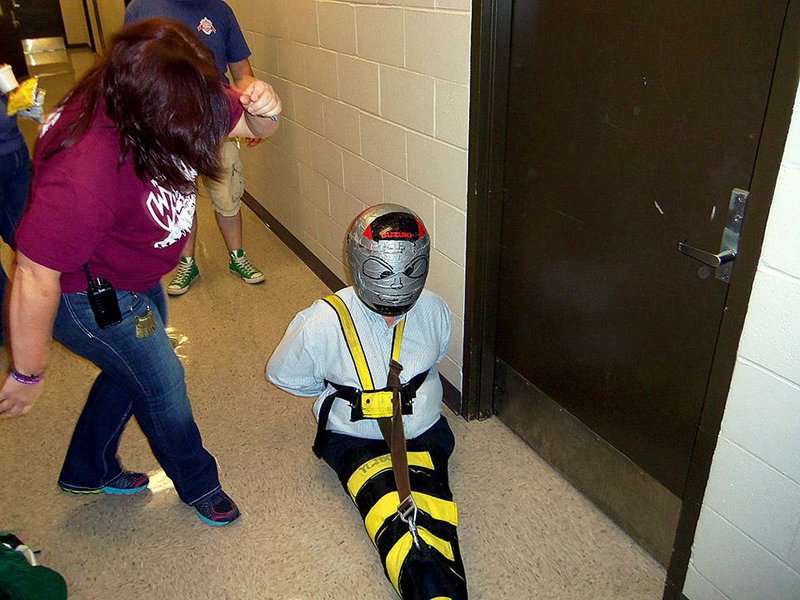The state Youth Services Division has directed the Yell County Juvenile Detention Center to stop restraining children in a manner that the state says is "potentially dangerous" and "exposes the youth to ridicule and humiliation," according to records obtained Wednesday.
In addition to using a restraint device that handcuffed children and immobilized their legs, staff members at the juvenile detention center in Danville placed a motorcycle helmet covered in duct tape over the youths' heads. The duct tape bore a hand-drawn, cartoonish face and covered the helmet's face shield, placing the restrained person in near total darkness.
Youths restrained in this manner were forced to stay in a sitting position with their hands behind their backs for two hours at a time and up to four hours with a "brief break," according to a letter from Youth Services Division Director Tracy Steele that tells the juvenile detention center to stop the practice and use of the device, known as The Wrap.
"The WRAP restraint system itself has no known therapeutic uses. As modified by Yell County JDC, the system violates the recommended guidelines of the manufacturers, exposes the youth to ridicule and humiliation, and presents serious risk of harm to the juveniles in your care," Steele wrote.
Steele's letter, dated Sept. 29, directed the 24-bed facility to immediately stop using the device on any youths committed to the Youth Services Division and urged the facility to abandon use of the device altogether.
In response to Steele's letter, Yell County Sheriff Bill Gilkey, who oversees the juvenile facility, directed staff members to stop using the device. It was removed from the juvenile detention center and placed at the sheriff's investigative unit, according to a letter dated Oct. 1.
Late Wednesday, a Youth Services Division spokesman said the agency would seek similar action at three other county-operated juvenile detention centers -- in Benton, Sebastian and Washington counties -- that use the restraining device in some fashion.
Administrators at two of those facilities defended the use of the device as an effective tool to prevent self-harm. Neither reported using the device as it was used in Yell County.
Capt. John Foster, Gilkey's chief deputy, said Wednesday that the restraint was removed from the Yell County facility within an hour after receiving notice from the Youth Services Division to stop its use.
"We take it very seriously, and we're going to be doing everything we can to try to ensure the safety of the juveniles in our custody," Foster said.
Foster said he and the sheriff were aware that The Wrap restraint was used at the juvenile facility, but they did not know about the use of the motorcycle helmet wrapped in duct tape.
"We were very troubled by that when we found out," Foster said.
"It was my understanding that they got [the helmet] without the duct tape as a means to try to protect the child's head if it was one that was trying to flail around. It's obviously not approved for that specific purpose," Foster said.
Foster said he did not know whether a staff member or youth placed the duct tape on the helmet.
The sheriff's office believed The Wrap restraint itself was a safe alternative to other restraints that can expose youths and adults to the risk of positional asphyxia -- when a person cannot breathe because of the body's posture or position.
"Our impression on it was that it was an approved use and that other facilities use it. We take it seriously, and we don't want to do things we're not supposed to do. That's why we took steps to change it," Foster said.
Foster said the sheriff's office is working the Youth Services Division to come up with an alternative method to restrain disruptive youths, but no plan had been determined as of Wednesday.
The correspondence regarding the use of the restraint device was included in records obtained Wednesday by the Arkansas Democrat-Gazette in response to requests under the Arkansas Freedom of Information Act that were sent to the Youth Services Division.
According to the letters, the manner in which the restraint device was used violates the agreement, known as a memorandum of understanding, between the Youth Services Division and the juvenile detention center that governs the treatment of youths committed to the division who are housed at the juvenile detention center.
The division uses several detention centers around the state and pays them daily amounts to house youths who are awaiting placement in state treatment centers or who have been removed from residential treatment programs because of disruptive behavior.
In 2013, 146 youths in the division's custody were housed in the Yell County detention center at various times, according to Youth Services Division records. The detention centers also hold other youths who are not in the division's custody.
Amy Webb, spokesman for the Arkansas Department of Human Services, said the Youth Services Division wasn't aware of any injuries to youths in the agency's care that resulted from the use of the device. She said the division didn't know how many youths had been restrained with the device.
None of the facilities that use the device has reported using it on youths in the division's custody, she said.
The division learned of Yell County's use of the device from Scott Tanner, the ombudsman for the state's juvenile-justice system, who found out about the practice in early September, she said.
In an interview Wednesday, Tanner said he learned of the restraint device's use while visiting with youths on an unrelated matter.
Youths described the restraint as "tortuous," he said, noting that the restraint was applied as punishment and in full view of other youths.
In response to a request under the state Freedom of Information Act, Tanner released photos of himself in the restraint device during a recent visit to the facility. He also released the letter he wrote to the juvenile detention center outlining his initial concerns about the device.
The photos show a step-by-step application of the restraint by staff members, using Tanner in place of a youth. Tanner is first handcuffed with his hands behind his back and then placed facedown on The Wrap restraint.
His legs are then bound using four yellow straps. He is then rolled over and placed in a sitting position. A harness is fastened over his torso that is hooked to a strap that extends to a metal ring near his feet. His handcuffs are clipped into a fastener on the back of the torso harness, the photos show.
The photos also show Tanner wearing a white helmet covering the top of his skull, but in a letter that he wrote to the facility, he noted that the helmet wasn't the one described by a youth he interviewed.
Another photo shows Tanner wearing the motorcycle helmet -- a red and black Suzuki helmet and visor with duct tape wrapped around it that obscures the wearer's view. Tanner noted that the helmets were switched during the demonstration after a youth pointed out that the motorcycle helmet was the one used on him.
"This appears to be a motorcycle helmet fully wrapped in duct tape with a cartoonish drawing of eyes, nose and mouth," Tanner wrote. "When applied to me, I found difficulty in breathing and, in turn, increased anxiety.
"For an individual that is already demonstrating behaviors that reportedly meet criteria in your center to merit this intervention, this specific head protector is counterproductive," he added.
Tanner also wrote in his letter that "multiple youth" reported concerns about "getting wrapped."
"All of the youth whom I interviewed that reported having been restrained in the WRAP and the youth who witnessed other youth in this restraint were consistent in their description: 'It is torture. This should not happen to kids,'" Tanner wrote.
The Wrap system is manufactured by California-based Safe Restraints. On its website, the company describes the restraint as a safe way for police, military, medical personnel and private security officials to restrain violent subjects. Most of the demonstrations of the product on the website show it being used on adults. Photos on the site show adults with their hands cuffed in front rather than behind them.
On the company's website, the Yell County Juvenile Detention Center's former administrator Kristi Padgett provided a written testimonial praising the product.
"With the WRAP, violent and aggressive juveniles can be restrained quickly and easily without harming them or endangering staff. The restraint is quick and easy to use and secures the youth until their behavior can be brought back under control," Padgett wrote.
Padgett went on to say she would recommend the device to other law enforcement agencies whether for youths or adults. She noted that the device had been in use at the facility for two years at the time of the testimonial, which was not dated.
A cellphone number for Padgett that had previously worked has been disconnected. An email sent to Padgett midday Wednesday wasn't returned by close of business.
Foster said Padgett had resigned at some point over the past few weeks and it was not related to the Youth Services Division's action taken regarding The Wrap.
According to a customer list on the Safe Restraints website last updated in July, 16 youth facilities in Alaska, Colorado, Indiana and Michigan have The Wrap. In addition to Yell County, another 27 juvenile detention centers nationwide have it as well, including facilities in Benton, Sebastian and Washington counties in Arkansas.
Denyse Collins, director of the Benton County Juvenile Detention Center, said her staff has access to The Wrap restraint but has used it only one time in a year and a half.
"It was only used with a kid who was physically beating her head against the floor. She was literally attempting to physically harm herself," she said.
Collins said The Wrap is a last resort when other means of de-escalating disruptive youths -- some of whom have severe mental health conditions -- have been exhausted. It is not used as punishment or the way it was used in Yell County, she said.
Jean Mack, director of the Washington County Juvenile Detention Center, said her facility also uses The Wrap.
"When utilized correctly we have no problem with that. It's very rare when we have to use it. We do follow all of the directions on how to use The Wrap," she said. "We've never had any issues whatsoever. It's a very safe restraint device when used appropriately."
A call to the Sebastian County Juvenile Detention Center on Wednesday afternoon was placed after the facility's director Capt. Fran Hall had already left. An email sent to Hall wasn't returned by close of business Wednesday.
Webb said the three facilities can expect to receive a letter from the Youth Services Division soon, directing them to stop using the restraint device. The division wasn't aware that the facilities used the device until they learned of the Yell County practice.
In his letter to Yell County, Steele wrote that the device was punitive -- a violation of the mission of the state's juvenile justice system, which is based on treatment and not punishment.
"It has come to the Department's attention that your facility routinely utilizes a highly controversial and potentially dangerous restraint procedure known as the 'WRAP' system," Steele wrote.
His letter directed the Yell County detention center to submit a corrective action plan within 30 days of his letter and stop using the device.
Failure to do so could result in the division withholding payment -- $75 per day per child -- or a decision to not house youths at the facility, Steele wrote.
Steele also noted that the device's use violates the Arkansas Juvenile Detention Standards, which govern the state's juvenile detention centers. The detention standards are enforced by state Criminal Detention Facilities Review committees.
A message left for Danny Hickman, the state coordinator of the facility review committees, wasn't returned late Wednesday.
A Section on 10/09/2014



